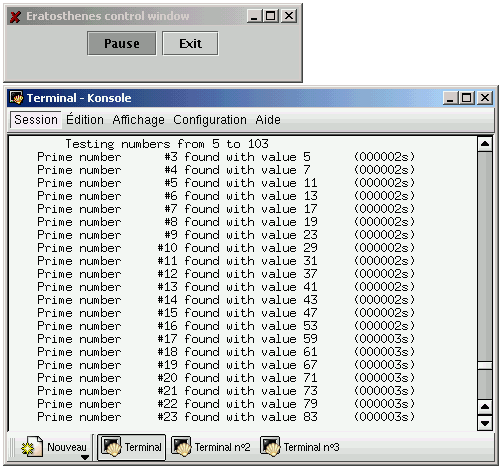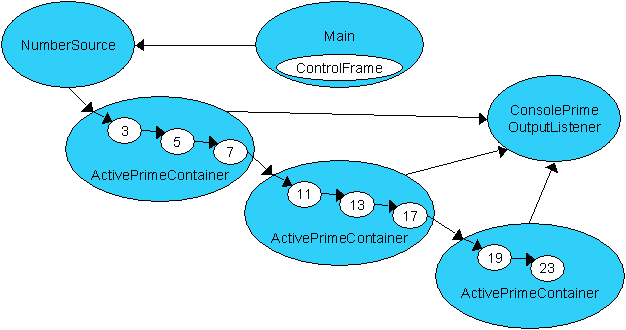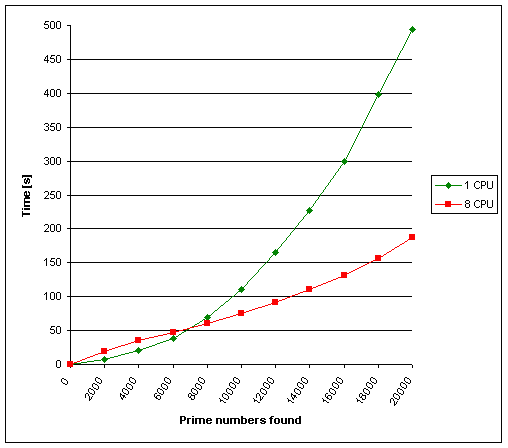
This program uses the Sieve of
Eratosthenes algorithm to find prime numbers. Numbers of increasing
size are tested if dividible by any previously found prime number. If
this is not the case, the number is a new prime number.
Active objects are used to store the prime numbers and to make the
tests, which allows to distribute the calculation on different
machines.
| Operating System | Path | Script name | Parameters |
| Unix | ProActive/scripts/unix/ |
eratosthenes.sh |
[-nogui] [XML deployment descriptor file] |
| Windows | ProActive/scripts/windows/ |
eratosthenes.bat |
[-nogui] [XML deployment descriptor file] |
All active objects except Main are
migratable using IC2D. You can use this to explore the different
latency times implied by calls to Nodes on other VMs or hosts. Pause
the application and wait for all containers to finish their current
work before migrating.
The parameter -nogui starts the
calculation immediately without opening a control window.

The control window has two buttons:
ActivePrimeContainers,
they continue their work until they run out of input.Prime number output is done on the console where you started the application, or on the node where the ConsolePrimeOutputListener is located if you migrated it.
The program stores the prime numbers in a linked list of
passive PrimeNumberImpl objects that are
controlled by active containers. Each PrimeNumberImpl
object has a pointer to the next PrimeNumber,
which may be a passive object in the same container, the next container
or null, if a bigger prime number has not yet been found.
Testing requests travel the chain of objects inside a container until a
divisor is found or the end of the container is reached and the request
is automatically being handed over to the next container. If the end of
the chain is reached, a new prime number has been found. FIFO serving
is required for the active objects in order to ensure that a number is
tested with all smaller prime numbers before being declared a new prime
number.
The source that enumerates the numbers, the result output handler and
the creator of new containers are active objects too.
ActivePrimeContainers have a link towards the previous container, so
that they can slow it down if they are overcharged with requests.
The program can be started on a single node or on
VirtualNodes described by an XML deployment descriptor. The number
source is created on a node described by NumberSource, the output
handler on a node described by OutputListener and the active containers
in the node(s) described by Containers. Four succeeding ActivePrimeContainer
objects are created on a node before continuing with the next node in
order to limit network traffic to a reasonable amount. An example of a
descriptor is given in descriptors/Eratosthenes.xml.
As a lot of method calls on active objects are produced in this example, requests accumulating in the request queues of the active objects can be observed using IC2D.
public
interface PrimeNumber
public long getValue()
- Returns the value of the prime number public void tryModulo(long
n) - Tries a potential prime numberpublic interface PrimeOutputListener
public void
newPrimeNumberFound(long n) - Reports a
new prime numberpublic interface
ActivePrimeContainerCreator
public void
newActivePrimeContainer(long n) -
Creates a new containerpublic interface Slowable
public void sleep(boolean
sleep) - Makes this container or source sleep or wake uppublic class
Main implements ActivePrimeContainerCreator,
InitActive
public void
newActivePrimeContainer(long n) -
Creates a new container that initially contains the prime number npublic class ActivePrimeContainer implements
PrimeNumber, Slowable, RunActive
public long getValue()
- Returns the value of the first prime number in the container public void tryModulo(long
n) - Tries a potential prime number starting with the
first prime number in the containerpublic PrimeNumber
newPrimeNumber(long n) - Creates a new
passive PrimeNumberImpl object in the
container or demands creation of a new container if the maximum size
has been reached.public void sleep(boolean
sleep) - Pauses work because of overcharge of the next
containerpublic class NumberSource implements
Slowable, RunActive
public void pause(boolean n)
- Switches number producing on or off because of user interactionpublic void sleep(boolean
sleep) - Switches number producing on or off because of
overcharge of the first containerpublic class ConsolePrimeOutputListener implements
PrimeOutputListener
public void
newPrimeNumberFound(long n) - Reports a
new prime number to the console
To make a basic test about the influence of distributed calculation, the program was run in a cluster environment with two different settings:
The time needed to find a certain number of prime numbers is shown below:
| Prime number found | Value | Time: 1 CPU |
Time: 8 CPU |
|---|---|---|---|
| 2000th | 7919 | 7s | 19s |
| 10000th | 104729 | 111s | 75s |
| 20000th | 224737 | 494s | 187s |

The difference between the single CPU and the multiple CPU setting shows the cost of inter-JVM-communication. With increasing numbers the distributed calculation profits from its CPU power, although the communication between the machines has to be done.
The Eratosthenes example was
written by Jonathan Streit.
| Feel free to send any suggestions to proactive@objectweb.org © 2001-2007 Inria Sophia Antipolis |